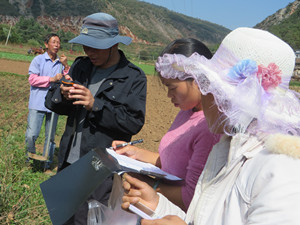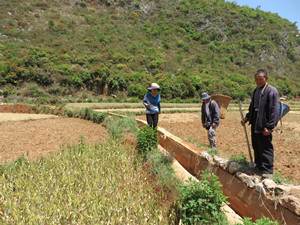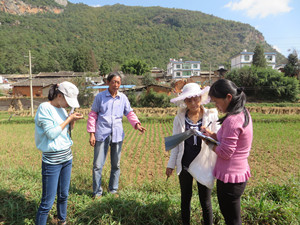Home \ Project News \ Project Story "Climate Smart Agriculture" carbon emission reduction project in Xundian
“Climate Smart Agriculture carbon emission reduction project” or “Farmers’ Clubs Xundian”is funded by the Blue Moon Fund and is operating in Xundian Hui and Yi Autonomous County in Yunnan. The project was officially launched on the 1st of January 2015 and is a two year program which will run until December 2016. The project is designed following the Humana People to People concept of Farmers’Clubs. The project operates in two Administrative villages covering a total of 400 households. The Climate Smart Agriculture Project advocates for the involvement of farmers in taking a lead on achieving positive results on carbon emission reduction, carbon sequestration and adaptation to Climate Change through climate smart agriculture.
Project Story—measure field by Xiang Songjun
It is February in Xundian and the air smells of early spring with the approach of the spring season. The farmers are used to the seasonal changes and have started preparing for the spring plowing work. The project has also started preparations for the Climate Smart Agriculture activities of SRI (System of Rice Intensification) planting. The project carried out an action of mobilizing farmers from village to village for them to participate in the project plan of planting rice this year using the SRI techniques. Project staff made assessments of the land to check on the planting area in order to calculate how much seed the project could buy and give to the farmers.
On the 29th of February the project carried out a training on SRI (System of Rice Intensification) techniques for the farmers in Nuoji village. Project staff also carried out an action to verify the planting area for the farmers so that they could calculate how much seed was required. A door to door action was carried out to make sure the verification process was up to date by visiting and seeing the planting areas. The farmers were informed that the project was giving 2kgs hybrid rice seed per mu per farmer according to the rice planting standards but the farmers suggested that the project should give out at least 3kgs of seed which they said could be enough. The project staff then explained the proportions of rice seed compared to planting area. The farmers then pointed out that they had given wrong figures about the planting area and that the area was bigger than the figures they had given to the project and that they hoped to receive more seed. This does not prove that the farmers are greedy but they lack knowledge of how much seed is required for a certain area due to their planting habits. Many farmers lack knowledge on scientific concepts of measuring on how much seed they should plant, how much pesticide to spray and how much fertilizer to apply. For example the farmers plant excess seeds out of fear that if they plant less it will not be enough. They do not realize that planting too many seeds is wasteful and that if the seedlings are closely packed they become weak due to lack of enough nutrients and breathing space. In this way there is also no guarantee that they have enough good rice seed to transplant.
There is a large gap between the methods the farmers are using in their traditional production of rice and the techniques used in applying SRI (System of Rice Intensification). Precision is not only for the project to carry out precise and quantitative cultivation of rice but it should fit with developing modern agriculture and to achieve sustainable development in rural areas. We certainly do not agree that farmers can simply change without any action. We told the farmers that we will measure rice fields area by area and from house to house. We would also distribute seeds according to the measurements of the actual area. No one was against our decision this time, they are all accepted the way of distributing the seeds by measuring the actual size of the area. But their faces were full of surprise as they thought it was not a big problem if we use one or two kg seeds extra per each household. Is it necessary to measure the land one by one? It is necessary for us as a project. This is a requirement that we carry out a "Climate Smart Agriculture” project in the village. We also need to use our actions, to guide the villagers to improve their skills in producing rice using the SRI technique.
Measuring of the fields went very well with the farmers leading us to their fields and they displayed a positive attitude to the action we carried out. There were some differences between the measurements some of the farmers had given us before compared to the actual measurements when we carried out the action. The farmers believed in our measuring instruments and the method we used, and they started to trust us.
 Project staff holding a GPS handheld instrument for field measurements
Project staff holding a GPS handheld instrument for field measurements Record measured data
Record measured data Villagers check the measurement process
Villagers check the measurement process

 FC Xundian is supproted by Blue Moon Foundation
FC Xundian is supproted by Blue Moon Foundation